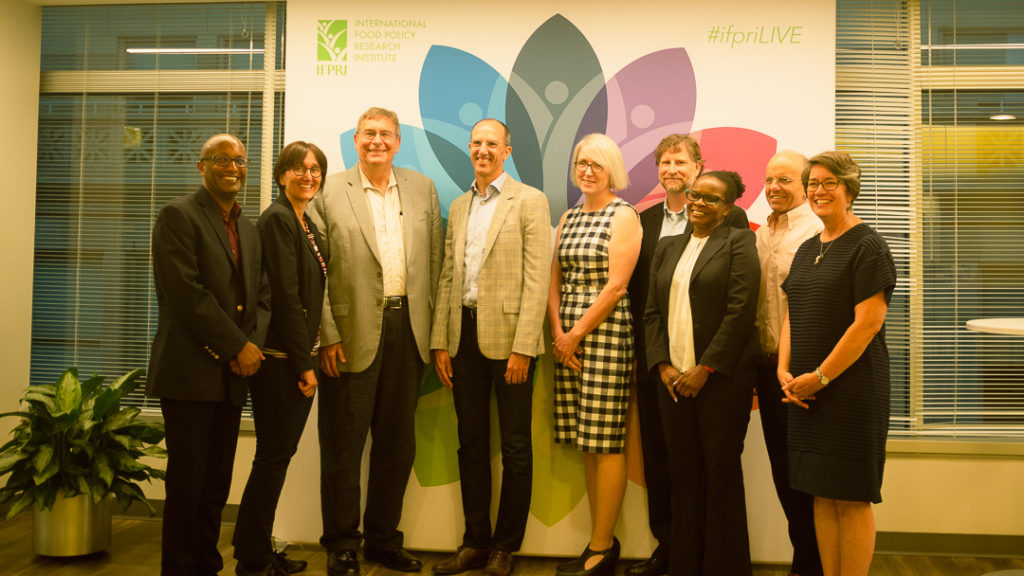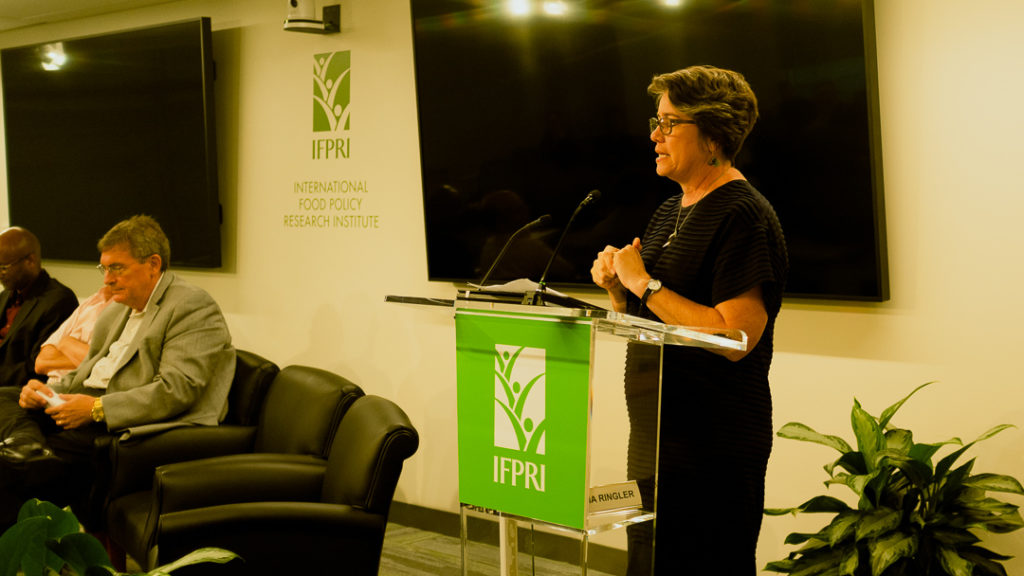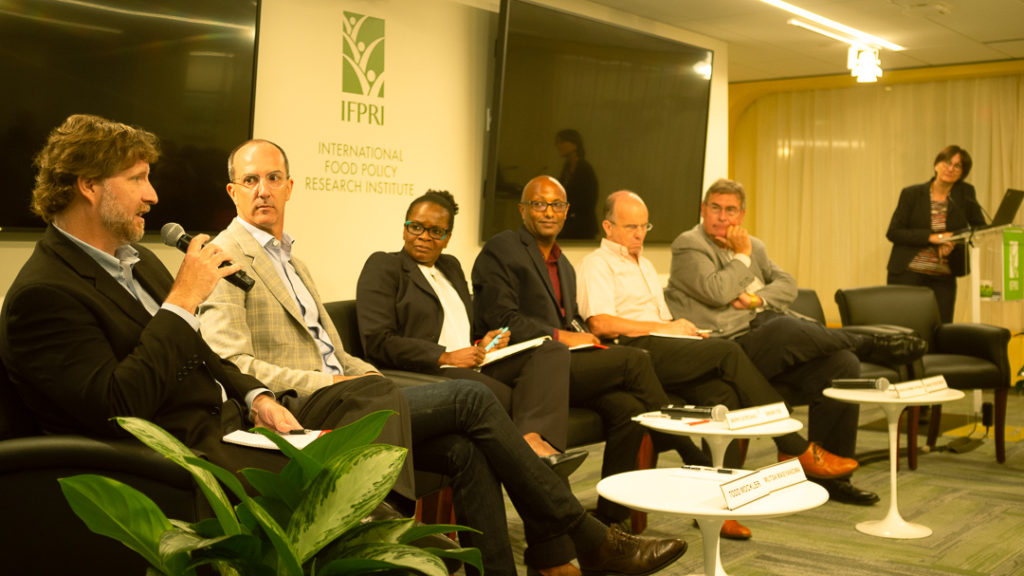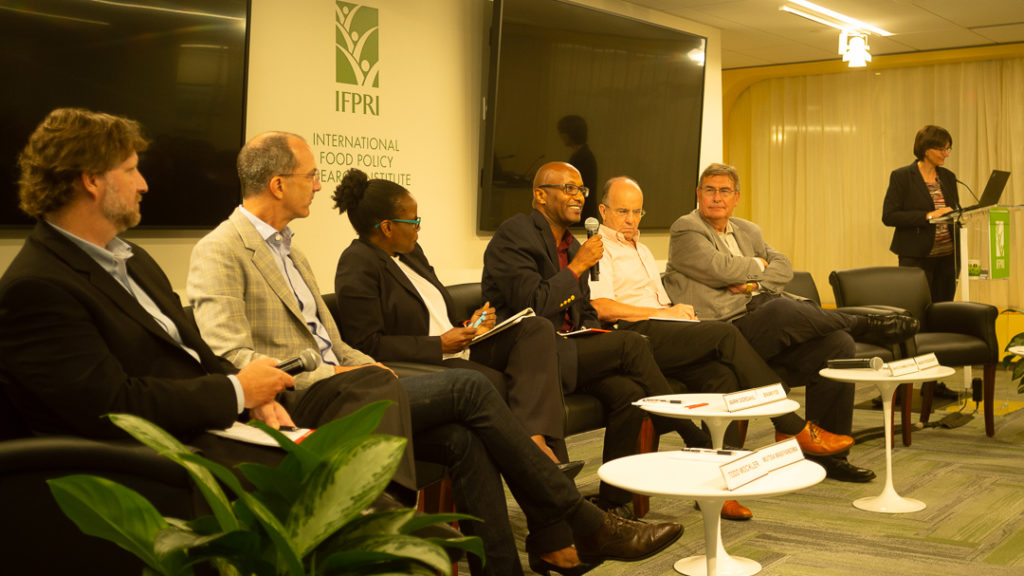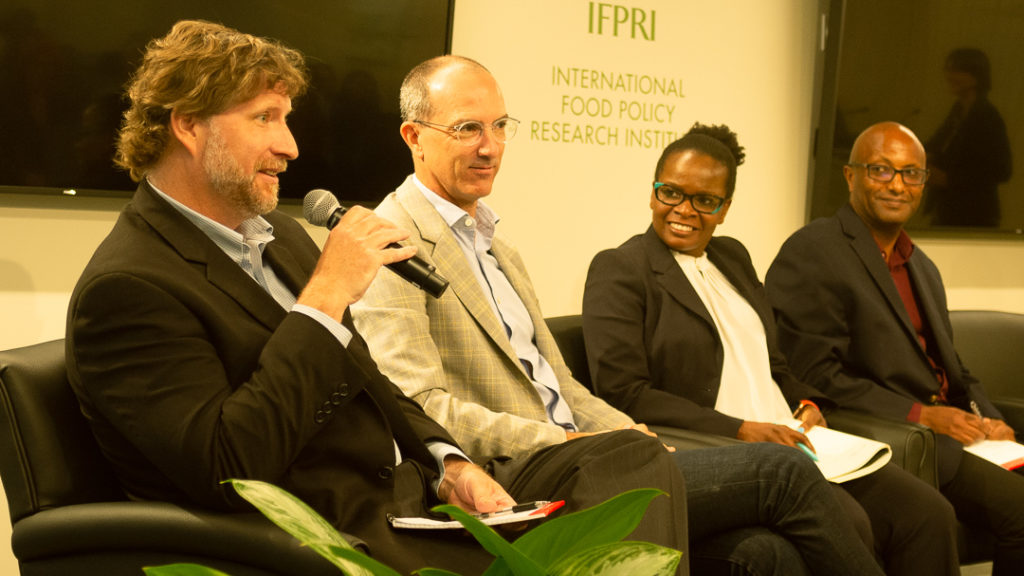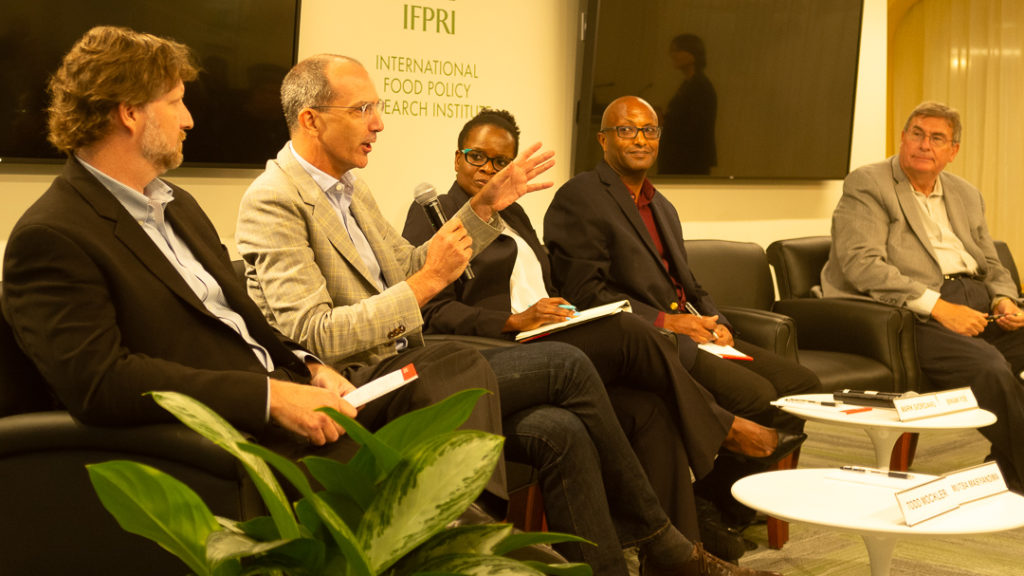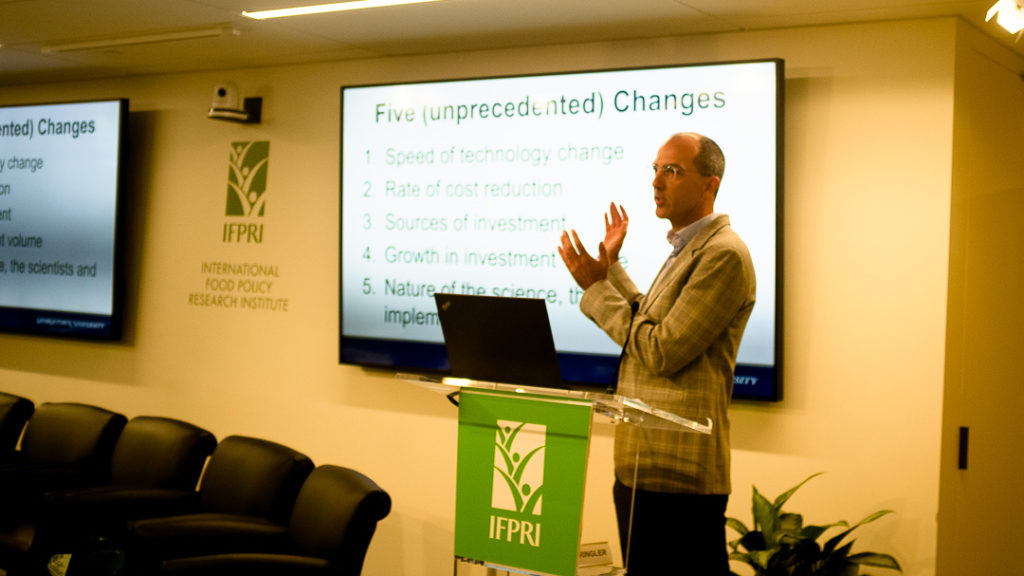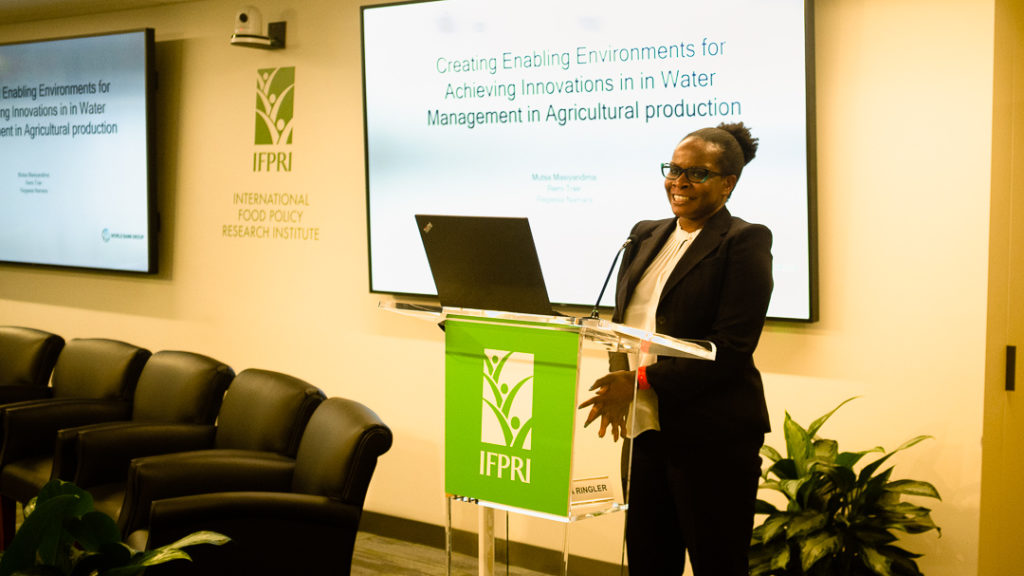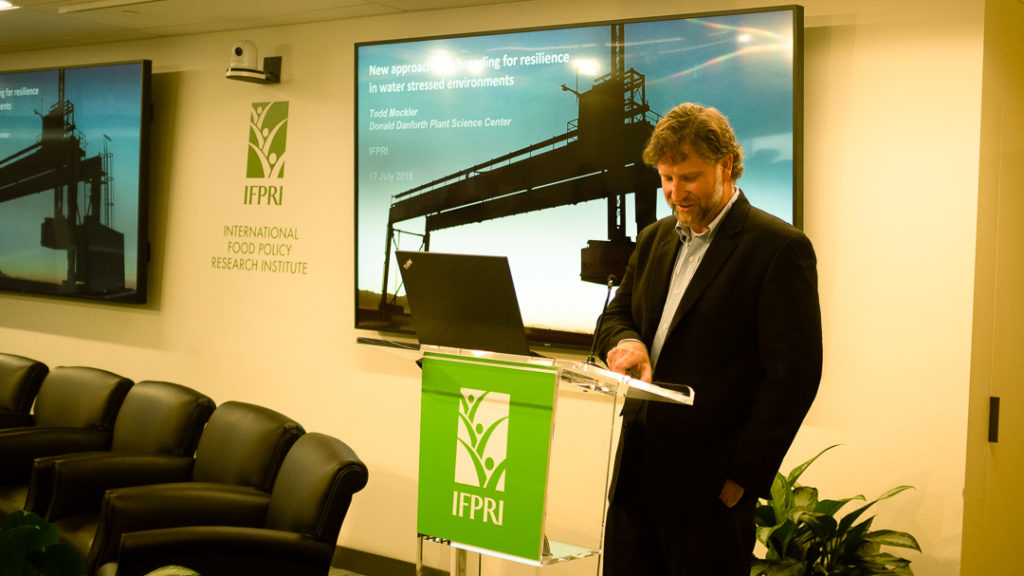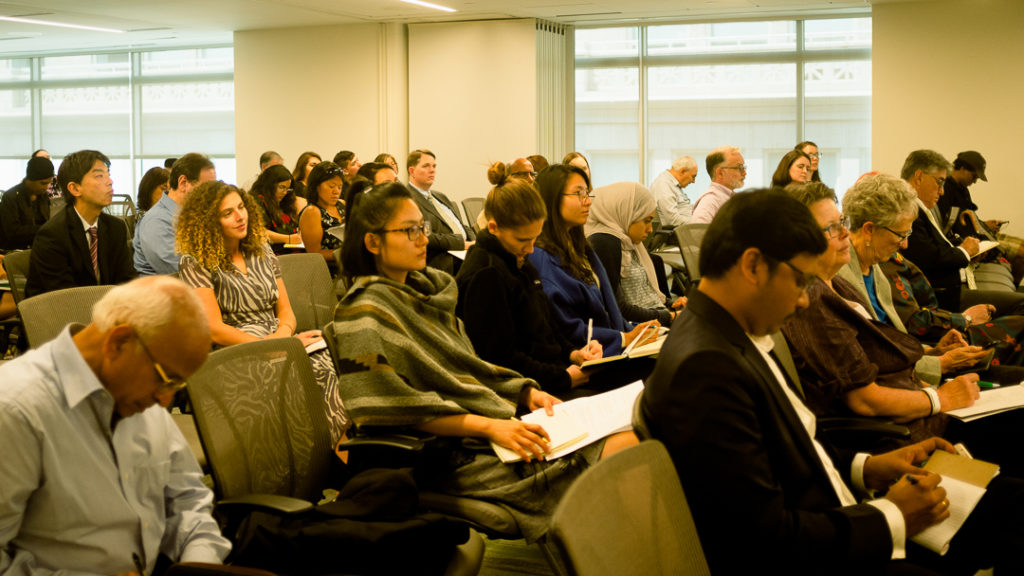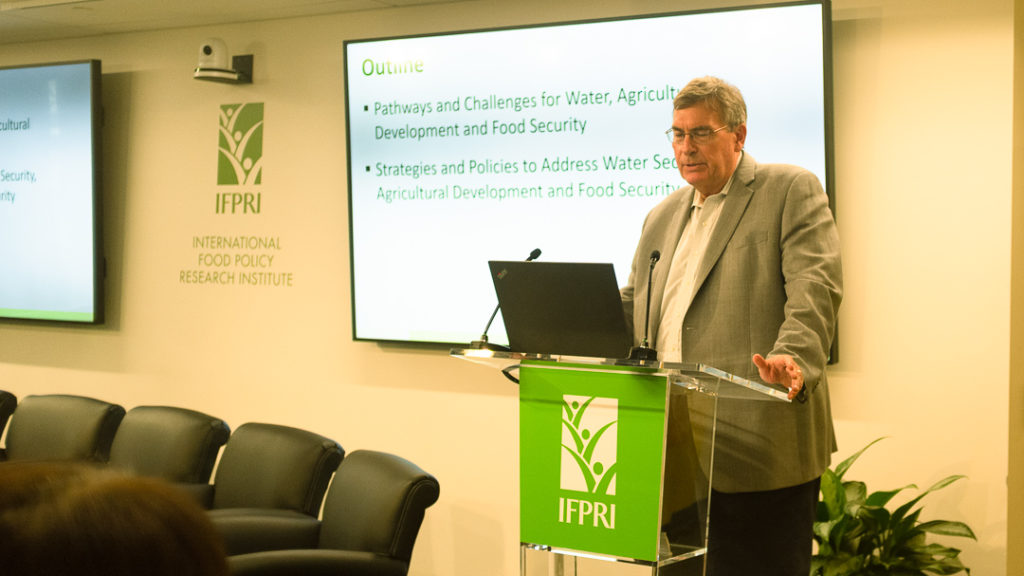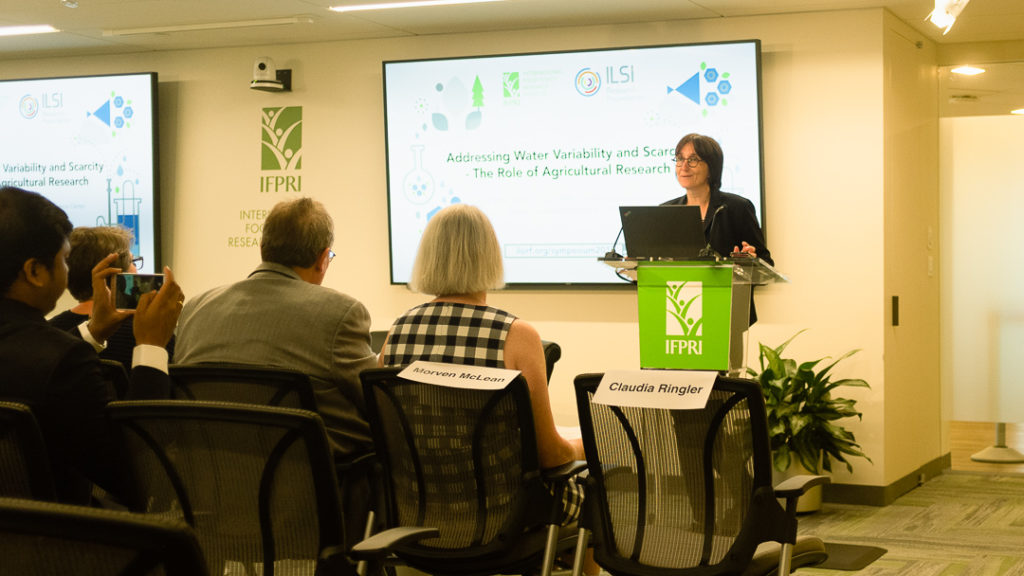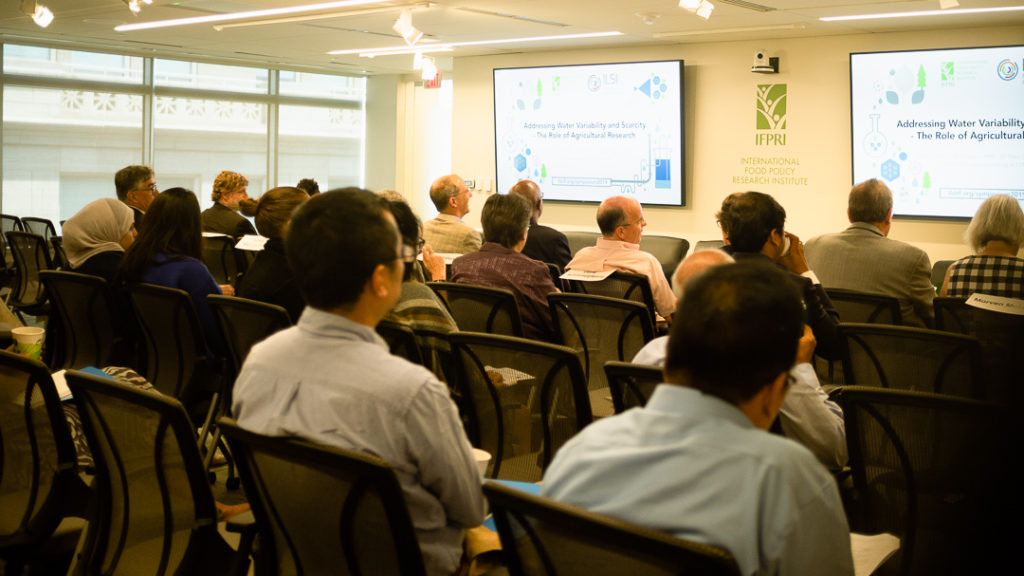Scientific Symposium: Addressing Water Variability and Scarcity – The Role of Agricultural Research
-
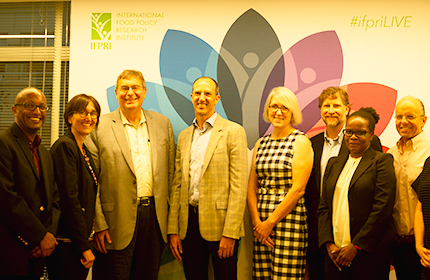
July 17, 2019
12:30 pm - 5:15 pmIFPRI - Twelfth Floor Conference Center - 1201 Eye St. NW
Washington, DC, USA
Overview
The Environment and Production Technology Division, International Food Policy Research Institute (IFPRI) and the Agriculture & Food Systems Institute co-organized the symposium Addressing Water Variability and Scarcity: The Role of Agricultural Research at IFPRI’s headquarters in Washington, DC. Presentations focused on new technologies that are being developed and/or applied to mitigate the impacts of water stress on agricultural productivity, as well as the enabling policy environment that is needed to ensure that water-related research and development efforts are effectively deployed and scaled up.
Speakers

Claudia Ringler, Ph.D.
Deputy Director, Environment and Production Technology Division, International Food Policy Research Institute (IFPRI)
Morven McLean, Ph.D
Chief Executive Officer, Agriculture & Food Systems Institute (AFSI)
Mark Rosegrant, Ph.D.
Research Fellow Emeritus, Director General’s Office, International Food Policy Research Institute (IFPRI)
Biniam Iyob, Ph.D.
Water and Irrigation Advisor, Bureau for Food Security, United States Agency for International Development (USAID)
David Schimmelpfennig, Ph.D.
Agricultural Economist, USDA Economic Research Service (USDA ERS)
Todd Mockler, Ph.D.
Geraldine and Robert Virgil Distinguished Investigator, Donald Danforth Plant Science Center
Mutsa Masiyandima, Ph.D.
Senior Irrigation and Drainage Specialist, Water Team - West Africa Unit, World Bank
Mark Giordano, Ph.D.
Professor, Georgetown University
Josette Lewis, Ph.D.
Director of Agricultural Affairs, Almond Board of CaliforniaAgenda
12:00 pm
Registration and Lunch
1:15 pm
Welcome and Introductions
Claudia Ringler, Ph.D., IFPRI
Morven McLean, Ph.D., AFSI
1:30 pm
Setting the Context
Mark Rosegrant, Ph.D., IFPRI (PDF)
1:50 pm
An Overview of Promising Technologies for Improved On-Farm Management of Water
Biniam Iyob, Ph.D., USAID
2:10 pm
What Can Precision Agriculture Offer to Small Holder Farmers?
David Schimmelpfennig, Ph.D., USDA ERS (PDF)
2:30 pm
Novel Approaches to Breeding for Resilience in Water Stressed Environments
Todd Mockler, Ph.D., Donald Danforth Plant Science Center
2:50 pm
Break
3:00 pm
Creating Enabling Environments for Achieving Innovations in Water Management in Agricultural Production Systems
Mutsa Cecelia Masiyandima, Ph.D., World Bank
3:50 pm
The New Agricultural Research Revolution, Water, and the Future of Public Sector Research
Mark Giordano, Ph.D., Georgetown University (PDF)
4:10 pm
Panel Discussion with Presenters
Q&A – Moderator: Claudia Ringler, Ph.D., IFPRI
5:00 pm
Summary Remarks
Josette Lewis, Ph.D., Almond Board of California
5:15 pm
End of Symposium
Abstracts
An Overview of Promising Technologies for Improved On-Farm Management of Water
Biniam Iyob, Ph.D., Bureau for Food Security, United States Agency for International Development (USAID)
Good on-farm management of water in developing countries could contribute in a major way to help vulnerable farmers out of poverty. Fortunately, we are in an era where technologies for on-farm water management are rapidly evolving. Water lifting technologies such as solar pumps have been undergoing product changes and price reductions that are increasing their adoption. Similarly water conveyance methods, such as drip irrigation, have also seen their accessibility and utilization increase in many developing countries. In addition to the technologies themselves, a strategic approach is needed to achieve widespread and sustainable adoption. Such an approach could result in improved food security, resilience, and nutrition. Four factors, called the four Ps, borrowed from the marketing field, might be useful for increasing adoption of sustainable practices for on-farm water management. First, the technology product has to fit the context and stakeholder preferences. Second, the price of the technology has to be reasonable to adopters. Third, the promotion of the technology has to be communicated well and at the right platforms. And, fourth, the technologies have to be available at the right place and time. However, these four Ps are not enough. Many other critical factors also need to be considered for the technologies to be sustainable (environmentally, socio-economically and politically). These factors include: the right crop type; good agronomic practices for fertilizer and seed; pest and weed management; access to markets for farmers to sell produce; resilience mechanisms such as insurance; equity considerations for gender and youth; and related policies.
Small Farm Use of Precision Technologies for Row Crop Production in the U.S.
David Schimmelpfennig, Ph.D., United States Department of Agriculture Economic Research Service (USDA ERS)
This paper considers characteristics of small farms that grow different row crops. These structural characteristics are then related to adoption rates for various precision agricultural technologies on small farms. Taking the smallest 10-15 percent of a nationally representative sample of farms growing each crop, small rice and wheat farms are over twice the size of small maize and soybean farms, and field sizes on these farms are much larger. This means that small maize and soybean farms have many more fields to manage using precision technologies. Soybean fields tend to be larger than maize fields on small farms.
Higher national adoption rates for precision practices on larger farms indicates that the smallest farms, and those with the most fields, may find adoption more difficult. Soil mapping adoption is higher on mid-sized small farms for most crops. Guidance is more widespread on all sizes of small wheat and rice farms, and they have the largest average field sizes. VRT seed, chemical, and fertilization are likewise more popular on larger small wheat and rice farms.
The results indicate that there is some use of each technology in most of the size categories of small farms. This is despite the fact that adoption increases with farm size for all row crops examined at the national level. Small farm adoption of PrecAg only goes to zero on the smallest farms for one crop – maize. This is the crop with the highest national adoption levels.
Novel Approaches to Breeding for Resilience in Water Stressed Environments
Todd Mockler, Ph.D., Donald Danforth Plant Science Center
Sorghum is the fifth most widely grown cereal crop worldwide and also an attractive system for the development of bioenergy feedstocks. It has innate resilience to drought and heat stresses, versatile end-uses, and a rapidly developing suite of genetic, genomic and phenomic tools. Drought is a complex trait, and identifying the genes underlying sorghum’s innate drought tolerance and how they are regulated requires advanced approaches in genetics, genomics, and phenotyping. Our approach has included sequencing and analyzing the genomes of several hundred racially, geographically, and phenotypically diverse sorghum lines representing all five major sorghum races. Sequencing ~400 sorghum genomes revealed millions of genomic sequence variants and identified candidate genes underlying several traits of interest. Exploration of the sorghum ‘pan-genome’ provided an initial catalog of “core” and “accessory” genes that are potential sources of adaptive alleles. Our work also leverages a field-based phenotyping infrastructure at Maricopa, AZ, which provides an exceptional capability for managed stress trials in a hot and arid environment through controlled irrigation. An automated field scanner system collects high-resolution phenotyping data using a variety of sensors throughout the growing season, from seedling establishment to harvest. Being able to assess the genotype-to-phenotype link in response to drought over the life cycle of the plant will facilitate the discovery of genes and their functions. Identifying the genes underlying drought tolerance will ultimately reveal the genetic basis for the remarkable phenotypic plasticity of sorghum.
Enabling Environments for Achieving Innovations in Water Management in Agricultural Production
Mutsa Masiyandima, Remi Trier, and Regassa Namara, World Bank – Water
Irrigation has the potential to accelerate growth in several countries, with benefits accruing to more than 180 million people and revenue in excess of US$20 billion annually. In SSA, such growth is a tool for reducing poverty. Many triggers and drivers for irrigation development exist, including climate change, decreasing farm sizes requiring intensification for farming to remain viable, more accessible and affordable technologies and services, and a proliferation of irrigation service markets. This presentation will be on creating enabling environments to harness the potential for expanding irrigation that exists. Focusing on Africa and with examples from Africa and Asia, we will discuss (a) existing barriers to innovation in water management for agriculture including environment, financing, issues of scale, capacity, and institutions, (b) priority enabling conditions to introduce and scale-up smallholder irrigation, (c) innovative financing mechanisms, (d) technologies, and (e) efforts required to address capacity challenges in reference to the need for extension services and technical assistance for smallholder farmers, especially when transitioning from rainfed to irrigated production and when the technological changes involves the change of crops. We will close with a brief discussion of the World Bank approach for scaling up farmer-led irrigation to enhance irrigation impacts.
The New Agricultural Revolution, Water Use, and the Challenge for Public Sector Research
Mark Giordano, Ph.D., Georgetown University
We are in the beginning stages of a biological science and information revolution that will have unprecedented impacts on agriculture including the ways in which crops use water and farmers respond to increasing variation in its availability. The revolution has so far been typified by 1) dramatic rates of technologic change and diffusion, 2) reductions in the costs of technology development, 3) change in the nature of the science, scientists and implementers involved, 4) transformation in the source of investment towards the private sector, and 5) rapid growth in the volume of investment targeting agriculture. The revolution holds tremendous potential for poor farmers, particularly those in regions bypassed by the original Green Revolution and traditional agricultural water investments. However, the nature of the new revolution is rapidly shifting agricultural priority setting away from national and international public sector and NGO actors as well as traditional agricultural researchers and research centers. These actors have a major role to play in informing and shaping the new revolution so that it benefits rather than harms the poor. Whether the role can be realized will depend on how quickly they can recognize and adapt to the new agricultural research environment.

